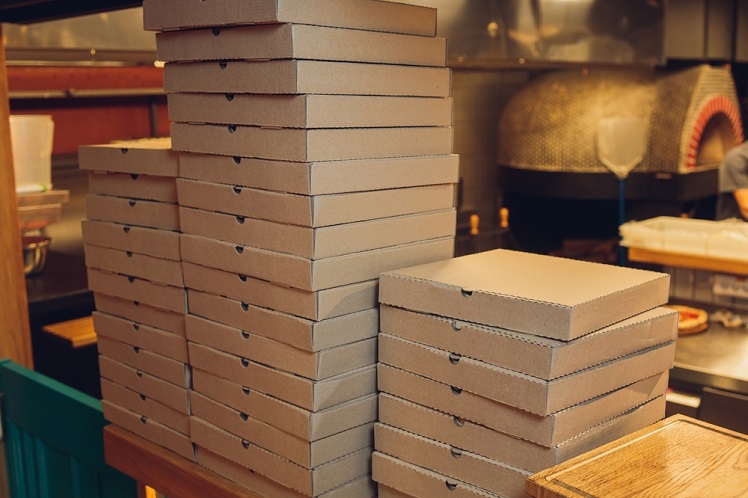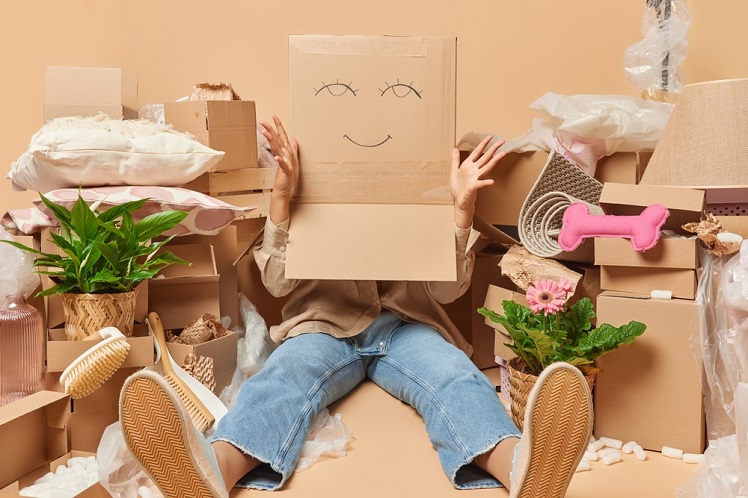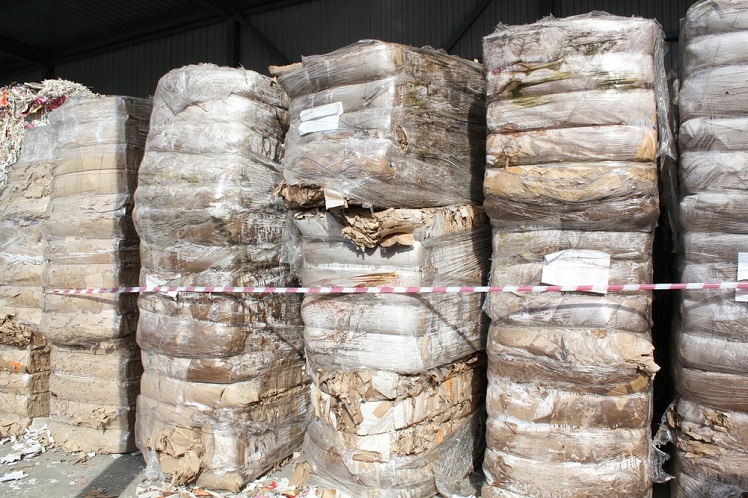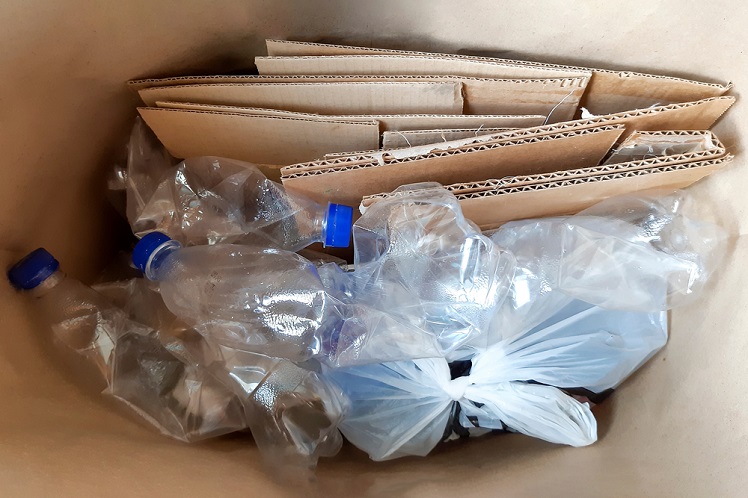To dispose of cardboard boxes sustainably, flatten and recycle them at local recycling facilities or use them for creative DIY projects at home.
Who doesn’t know cardboard boxes? These materials are popular as packaging materials for foods and goods. Besides being cheaper than wood, cardboard is also versatile and lightweight. Thus, many manufacturers nowadays turn to this material to ship their products. However, there’s a bitter truth between these wonderful features.
The production of this packing leaves a lot of cardboard waste behind. Not to mention that people don’t have a good understanding of how to dispose cardboard boxes properly.
Poor waste management and disposal of materials can lead to catastrophic impacts on our earth. Knowing that they are made of cellulose, we must find a way to recycle cardboard boxes at home. Or not, understand the cardboard recycling process and the disposal of non-recyclable cardboard. as well.
To know more about how to recycle and how to dispose cardboard boxes safely to the bin, read the following sections to the end!
Key Takeaways
- Cardboard boxes can be recycled or creatively repurposed at home to avoid landfill waste.
- The production of cardboard contributes significantly to carbon emissions and energy consumption.
- Cardboard decomposes in about two months, but packaging with mixed materials takes longer.
- Improper disposal of cardboard can lead to environmental issues, including increased landfill waste.
- Alternatives like honeycomb packing paper and biodegradable air pillows offer sustainable packaging options.
Table of Contents
About Cardboard Boxes
You must be familiar with cardboard boxes. They are widely used as packaging for goods and food, which makes them easy to transport. However, do you know that empty boxes of non-recyclable cardboard are wasted in landfill? Meanwhile, the recyclable ones only stay in the recycling bin.

Therefore, we will discuss in detail the impact of these materials on the environment and whether or not they are made of hazardous materials in the following sections.
1. What Are Cardboard Boxes Made Of?
Judging from its characteristics, you can easily tell that cardboard boxes are made of the same material as paper, cellulose. Usually, cellulose is obtained from pine trees with a fast growth rate. Thus, ensuring sustainability in the process.
But nowadays, the production of cardboard tends to use recycled paper, known as a flute, to make layers in the box. These covers ensure safety for the products packaged with cardboard boxes. Considering such ingredients, it’s understandable that they are cheaper than wood crates.
2. Harmful Chemical In Cardboard Boxes
Even though recycled boxes are preferable due to their affordable cost for packaging, they are not safe. And in fact, contains hazardous materials that are potentially harmful to our health and the environment.
According to BBC News, recycling cardboard boxes for food packaging pose health risks. The mineral oils from printing inks in the cardboard boxes can leak into the foods, even though they are used as an outer layer in the packaging. Moreover, the researcher, Dr. Grob, told BBC News that two possible health risks haunt those exposed to the chemicals: internal organ inflammation and cancer, to say the worst.
This risk is way higher if the boxes are used to pack warm or hot food since it contains plasticizers (phthalates). Suppose this toxic chemical builds up in your body. In that case, you may experience asthma, thyroid dysfunction, and allergy. In children, phthalates can interfere with growth and development.
Furthermore, the cardboard boxes’ pulping process generally uses sodium hydroxide and sodium sulfate. Both chemicals, especially sulfate, can accelerate acidification in water and soil, which triggers acid rain.
3. Why You Shouldn’t Keep Cardboard Boxes?
Many people think cardboard boxes are recyclable. And that’s true! You can recycle corrugated cardboard by throwing them into cardboard recycling containers. Then, send them to the recycling center. It is also possible to recycle cardboard boxes at home.

For example, turning them into drawer dividers, protecting floors from spilled paint, or creating a mini cat house for your lovely pet. However, we don’t recommend keeping cardboard boxes as storage. Why so?
- They can absorb moisture which triggers mold growth. While it seems harmless, there is a lot of news about mold poisoning due to inhaling its toxic spores.
- Besides, you will deal with pests like rats and rodents that love to nest inside damp and dark boxes.
- Mildew can grow in the cardboard you stack up to the ceiling.
- The cardboard pile can reduce the air quality in your house due to the pile of dust that sits on the surfaces.
How Long Does Cardboard Boxes Take To Decompose?
Unlike non-paper packaging, such as plastics, glasses, and metals, which take up to hundreds of thousands of years to decompose, cardboard boxes require only around two months! It is possible due to their raw material, which is the same as making paper (cellulose!). However, the decomposition period highly depends on the type of cardboard.

Some food manufacturers use Tetra Pak, which comprises 75% paper cardboard, 20% polyethylene, and 5% aluminum. They are generally used to pack beverages (milk and juice) to prevent leakage of the liquid product.
Besides, those materials are also beneficial to ensure food safety of the food product. Polyethylene is moisture-resistant. Thus, it can reduce moisture absorption, which often triggers mold growth. Meanwhile, aluminum prevents product leakage and maintains the temperature of the perishable products.
Considering the material, it’s no wonder the packaging takes longer to break down, around 5 years. While you can ditch the cardboard straight into the recycling bin, these liquid paper boards must first go through a separation process with plastic. Some are not even recyclable.
Data reported that the Tetra Pak producers can generate 190 billion of non-biodegradable packaging per year, which adds up the cardboard waste in the landfill. What a shocking number!
You might also like:
- Eco-Tips: How To Dispose of Old Perfume Safely and Responsibly?
- Eco-Tips: How To Dispose of Nail Polish Safely?
- Eco-Tips: How To Dispose of Old Lipstick Responsibly?
- Eco Tips: How To Dispose Of Charcoal Ashes Harmlessly for Environment?
- Eco-Tips: How To Dispose of Makeup Brushes Properly?
Cardboard Boxes Environmental Problems
There is a debate among manufacturers and consumers regarding the sustainable option between plastics and cardboard boxes. Those with common beliefs ensure that paper-based packaging, like cardboard, is environmentally friendly since cardboard boxes are recyclable.
So, they only need to find the best way to recycle these materials. Contrary to that, plastic producers argue that plastics have more excellent durability than cardboard. Consequently, you can reduce the disposal of materials sent to landfill.
Well, it may be confusing to absorb. But that’s the bitter truth. According to data, the production of cardboard boxes generates 4x more carbon emissions than plastic. In addition, they are heavier than plastics which eventually require more vehicles to transport the materials. And so, it adds up to the carbon emission because of the need for fuel.

Furthermore, the environmental problem doesn’t just stop there. Making cardboard boxes which consists of cutting trees, mixing, pulping, and drying also requires a lot of energy. The Guardian even reported that the paper and cardboard manufacturing industry is the top three largest industries that consume a lot of energy to operate their companies.
In fact, a company named Guy Watson mentioned that 10% of its carbon footprint comes from manufacturing and cardboard recycling processes. Even though the recyclable rates of these materials are five times higher, this has the potential to accelerate global warming. Another report said that it takes 91% more energy to recycle a pound of empty boxes of paper cardboard than a pound of plastics.
Meanwhile, the non-recyclable ones along with poor waste management will add more cardboard box waste to the environment. Not to mention the exploitation of the trees used to make paper boards, this situation worsened.
The Right Ways On How To Dispose Cardboard Boxes
After knowing various exciting and astonishing facts related to these materials, we have now come to the most critical section, which will discuss how to dispose of cardboard boxes safely.
Knowing that they are recyclable, you can use empty boxes to create some interesting stuff! Interested? Let’s find out how to recycle them!
1. Collect Them in The Council Recycling Bin
Each council usually has a bin to put cardboard boxes for recycling. To save space, you can flatten the boxes before dumping them. Then, tie them together so the box collectors can handle them easily.

2. Bring The Boxes To The Nearest Recycling Center
Instead of waiting for the waste collectors to come every other day, you can take the pile of boxes to the local recycling center. They are commonly free of charge. But, it would be better to check out some info on their website or phone them to ask about the disposal fee.
You can take advantage of social media access to offer your boxes online for free. Provide a list of items and a description of their sizes to make it easier for those interested to know details about your cardboard. Usually, they will be recycled or repurposed into other valuable items, such as handicrafts.
4. DIY Cardboard Boxes
If you have non-recyclable cardboard boxes and don’t know where to dispose of them, you can use your creativity skills by designing a cat house. Try playing with colorful paints to make the brown cardboard turn into fun pieces. Besides being a comfortable place to rest, you can create a mini maze for your cats to walk along the path. What’s more?
While you can dump the recyclable ones into the cardboard recycling containers, the non-recyclable ones are also better used to make other useful things. One thing you can do is make stunning curtains to cover your windows. First, sketch the boxes according to the shapes you want. Then, color it with paint and attach it to the hemp rope with glue or tape.
Cardboard Boxes Environmentally Friendly Alternatives
Even though you have understood some tips on how to dispose of cardboard boxes without harming our environment, it would be better to know some alternative products that can reduce their use. They can reduce the impact, thus protecting the goods you pack with these alternative eco-friendly materials. What are those?
1. Honeycomb Packing Paper
Despite being made of paper, the honeycomb structure ensures elasticity which can protect your belongings. They are stretchy and can be easily adapted to the various shapes of objects that you will pack with this environmentally-friendly packaging.
You can try to buy one from the Bersitek brand, which is generally used to wrap perfumes, artworks, and various other fragile items.
2. Inflatable Air Pillow
People use cardboard boxes for safety. But there are more environmentally friendly alternatives that you can choose. One of them is this biodegradable inflatable air pillow from Sealed Air.
The water isolated in the pillow-like shapes guarantees protection for the fragile items you pack. Since it will be wasteful if you use it alone, you use your suitcase to pack your things. Then, put the pillows inside.

3. Recycled Packing Peanuts
Suppose you have no access to inflatable air pillows but desperately need green alternatives to cardboard boxes. In that case, you can rely on recycled packing peanuts. The cushion-like texture guarantees safety for your fragile goods.
Again, suitcases or bags are necessary to pack your stuff. Then, fill them up with these packing peanuts. If you are interested, check on the product from MagicWater Supply.
Final Thought
The best tip on how to dispose of cardboard boxes is to send cardboard boxes for recycling. They will be recycled into brand-new cardboard or recycled paper. Thus, having a better value than being left lying in the trash. Apart from that, you can make various interesting crafts out of this waste.
If you have kids, you can be more playful in making these boxes a tool to hone your children’s creativity. As for the alternative, our experts highly recommend using suitcases or bags, along with biodegradable air pillows or packing peanuts, to reduce box waste.
Latest Post:
- Bioplastic Pros and Cons: An Unbiased Examination
- Eco-Friendly Bottling: Aluminum as the Sustainable Hero?
- How to Make Bioplastic from Rice: A Step-by-Step Guide
- Eco-Tips: How to Recycle Amazon Envelopes?
- What Does Compostable Mean?
FAQs (Frequently Asked Questions)
Is cardboard cheaper than wood?
Before cardboard boxes were invented, wood was a favorite packing material for shipping boxes. Especially those that are fragile, like those made of glass. However, the increasingly high price of wood has made many manufacturers replace it with cardboard boxes.
These materials are way cheaper and pretty versatile. Compared to wood crates, cardboard products are lighter. Thus, making them easier to move and distribute.
What material is better than cardboard?
Even though cardboard products are made of cellulose, the production leaves a lot of cardboard box waste. Hence, it may not be your best option to start living an eco-friendly lifestyle that adopts sustainability.
For the alternatives, we suggest non-paper packaging like recycled plastics. They are durable, versatile, and water-resistant. Thus, you shouldn’t worry about the safety of your shipping boxes. However, choose the recycled ones or those with triangle symbols that indicate the products are recyclable.
Can cardboard contaminate food?
The food packaging materials have a vast development nowadays. While people started to leave non-paper packaging due to its negative impacts on the environment, cardboard comes in various attractive shapes and colors as a brand new packing material.
However, it turns out that these materials are not quite safe, especially the recycled ones. To recycle cardboard boxes, manufacturers usually use chemical inks that can transfer to food. In fact, corrugated cardboard for individual packing are also not resistant from this contamination.
Do cardboard boxes attract rats?
Beware if you store cardboard boxes in your attic since rats love to reside in them. These materials are made of cellulose that can absorb moisture and tend to get warm quickly.
Besides, they are also not transparent, which easily gets dark, especially if you keep them in places like attics or warehouses. Also, the paper-like material is easy to break down by rodents, making the boxes a comfortable nesting place.
